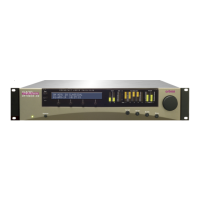3-34
OPERATION ORBAN MODEL 9400
standard on early OPTIMOD-AM 9100 units and was later provided by the 9100’s
green module. Compared to higher settings of the HF Curve control, it provides
much more boost in the 5 kHz region, and tends to sound strident on wideband ra-
dios. However, it can be very effective where narrowband radios remain the norm.
With an HF
CURVE setting of 0, an HF GAIN control setting of 22 dB will create a per-
ceived bandwidth of 6 kHz on “Group 2” AM radios (see page 3-11); a 15 dB setting
yields a 5 kHz perceived bandwidth, 10 dB yields 4 kHz, and 5 dB yields 3 kHz. Ad-
vancing the HF
GAIN control will result in a brighter, higher fidelity sound, but it will
also require that the listener tune the radio more carefully.
If most of your listeners have wider-band radios (as may be the case in North Amer-
ica), use the NRSC curve, which can be chosen with the HF
CURVE control. For a
somewhat brighter sound that can benefit narrowband radios more, yet is still com-
patible with wideband NRSC radios, use HF
CURVE = 10 and HF GAIN = 10dB. HF
CURVE = 10 corresponds to the RED pre-emphasis module in Orban's analog
9100-series OPTIMOD-AM processors.
Note that the added brightness caused by using an HF
CURVE of 10 (as opposed to
using NRSC) may tend to increase the first-adjacent interference being generated by
your station, contrary to the purpose and intentions of the NRSC.
HF
CURVE settings between 0 and 10 smoothly interpolate between the two ex-
tremes, and provide more flexibility for user adjustment. An HF
CURVE setting of 5
provides the curve family associated with the YELLOW pre-emphasis module in
Orban's analog 9100-series OPTIMOD-AM processors.
With the HF
CURVE control at any setting other than NRSC, extreme amounts of
high-frequency boost may result in a slight `lisping' quality on certain voices. This is
because the high-frequency boost will increase the high-frequency content of sibi-
lant voices, which can only be boosted to 100% modulation. Since the spectral bal-
ance of the voice is altered, this may be perceived as a lisping sound.
The receiver equalizer is of limited benefit to narrowband radios with abrupt rol-
loffs. We believe that these radios benefit more from a boost at 3 kHz, combined
with very little HF shelving EQ. These radios have almost no response at 5 kHz and
above, so boosting frequencies above 5 kHz wastes modulation. Using a bell-shaped
boost at 3 kHz causes the boost to decline naturally at frequencies that the radio
cannot reproduce. You can use either the midrange or HF parametric equalizer to
create such a boost.
Figure 3-1 on page 3-33 shows the curve families for the HF equalizer.
DJ BASS
(“DJ Bass Boost“) control determines the amount of bass boost produced
on some male voices. In its default O
FF position, it causes the gain reduction of the
lowest frequency band to move quickly to the same gain reduction as its nearest
neighbor when gated. This fights any tendency of the lowest frequency band to de-
velop significantly more gain than its neighbor when processing voice because voice
will activate the gate frequently. Each time it does so, it resets the gain of the lowest
frequency band so that the gains of the two bottom bands are equal and the re-

